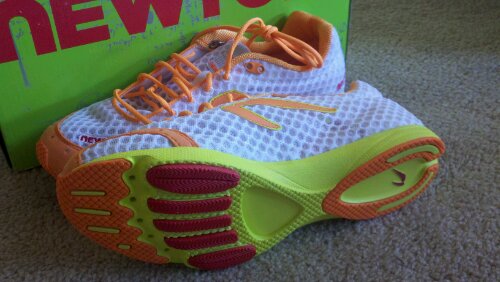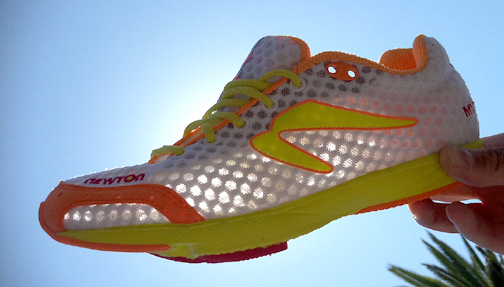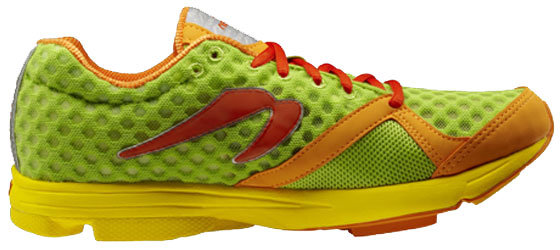 If you liked the 2011 Newton Distance you are going to love the 2012 Newton Distance. The 2012 Newton Distance has all the things you liked about the 2011 model, but is now more lightweight, with a much sleeker profile.
The Newton Distance is a natural running shoe that lives up to its namesake. This is a distance runners lightweight trainer. Light enough for the short runs, or even racing, but it is the sustained comfort over long distances that really makes this a distance runners shoe.
If you liked the 2011 Newton Distance you are going to love the 2012 Newton Distance. The 2012 Newton Distance has all the things you liked about the 2011 model, but is now more lightweight, with a much sleeker profile.
The Newton Distance is a natural running shoe that lives up to its namesake. This is a distance runners lightweight trainer. Light enough for the short runs, or even racing, but it is the sustained comfort over long distances that really makes this a distance runners shoe.
Zero Drop?
The near level profile of the Newton Distance promotes a natural forefoot stride. The willingness to create running shoes that do not have a raised heel is the defining feature allowing innovative shoe companies such as Altra and Newton to carve out a piece of the overcrowded running shoe market.
At 2mm, the heel-toe differential of the Newton Distance is half that of the Nike Free 3.0, the Brooks Pure, or even the first model of the New Balance Minimus, which all fell 4mm short of a zero drop shoe.
Unlike the Newton MV2 the, the Newton Distance is not zero drop, but with only a 2mm differential between the forefoot and the heel, they might as well be zero drop, which of course begs the question as to why they are not zero drop. (Perhaps like the Newton MV2, the Newton Distance could be made zero drop and ship with a 3mm insert to help transitioning for those not yet accustomed to a zero drop shoe.)
Lightweight
When it comes to running shoes, lighter is better. The 2012 Newton Distance weighs in at only 7.8 ounces, nearly an ounce lighter than the 2011 model.
Design
If you have a near level profile, show it off. That is exactly what Newton has done in the 2012 model of the Newton Distance. In the 2012 model, Newton removed unnecessary EVA from around the heel of the shoe. This not only removed weight, but also made for a much sleeker looking shoe, and let's face it, looks do count.
If you are like me, you like your running shoes loud, and the Newton Distance is just this. With vibrant shouting colors these shoes get noticed, though I do wish that more color options were available.
Outsole
The defining feature of a Newton outsole is the lugs beneath the forefoot. After decades of putting air pockets, and gel pockets, and springs and any number of other ridiculous features in the heels of running shoes, I applaud Newton in in placing protection under the forefoot where it is needed most. I did however find that I prefer the five lugs of the MV2 over the four lugs of the Newton Distance.
Upper
The lightweight mesh upper is very breathable, does not absorb water, and like I mentioned before, comes in screaming loud colors. One advantage the Newton Distance has over the Newton MV2 is the sidewall at the widest part of the foot. This somewhat stretchy sidewall allows for foot splay even for wider feet, and is durable enough to not blow out even with extended use.
Toe Box
Though not foot shaped, the toe box of the Newton Distance is generous and will allow even wide feet to splay without causing blisters or blowing out the sidewall
Comfort
Comfort is the category where the Newton Distance really stands out, particularly for really long runs or races. The MV2 is sleeker, and more lightweight, but the Newton Distance trainer stays comfy even when passing mile 25.
Sizing
Sizing is tricky with Newton shoes. I am a size 1o.5. To get a proper fit with the MV2 I went with a size 11 and the toe box was still rather narrow. The Newton Distance however, seems to fit more to size, but you may wish to try them on before buying.
What I liked Most About the 2012 Newton Distance
- Only 2mm drop
- Lightweight
- Durable
- Comfortable
- Loud Colors
Things I would like to see in the 2013 Newton Distance:
- Zero drop (with insert for transitioning)
- standardized sizing
- More color choices
Overall
 Shoes do not make the runner, but wearing the right shoe helps. The Newton Distance promotes proper natural running form, and that is why Newton is such a fast growing brand in the running world. The near level profile of the Newton distance encourages a midfoot/forefoot stride, but ultimately it is up to the runner to implement this natural running form.
Shoes do not make the runner, but wearing the right shoe helps. The Newton Distance promotes proper natural running form, and that is why Newton is such a fast growing brand in the running world. The near level profile of the Newton distance encourages a midfoot/forefoot stride, but ultimately it is up to the runner to implement this natural running form.
Even as lightweight as the it is, the Newton Distance is still more shoe than I am accustomed to. For my shorter runs I prefer a the Newton MV2 over the Distance, for those really long runs the Newton Distance provides comfort unmatched by the barefoot shoes to which I am accustomed. This shouldn't be surprising, it is named the Newton Distance precisely because it is a shoe designed with those long distance runs in mind.
Buy the Newton Distance at NewtonRunning.com
What was your experience with the Newton Distance Trainers? Leave your comments below.

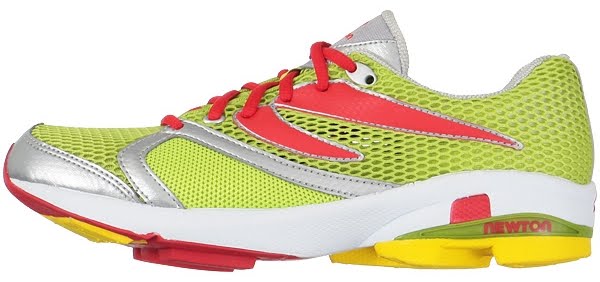
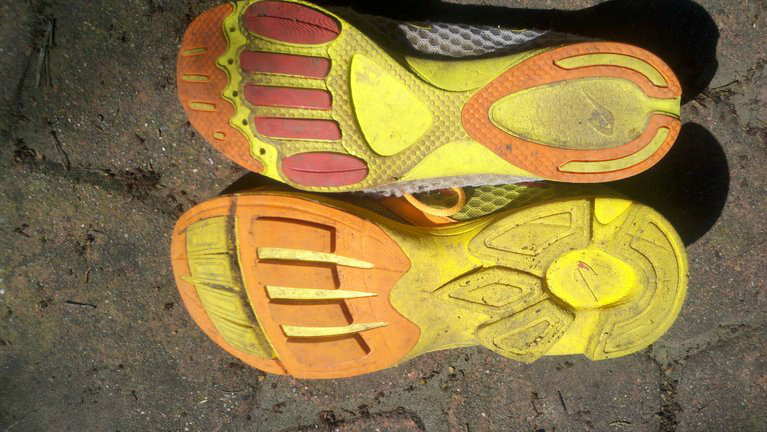

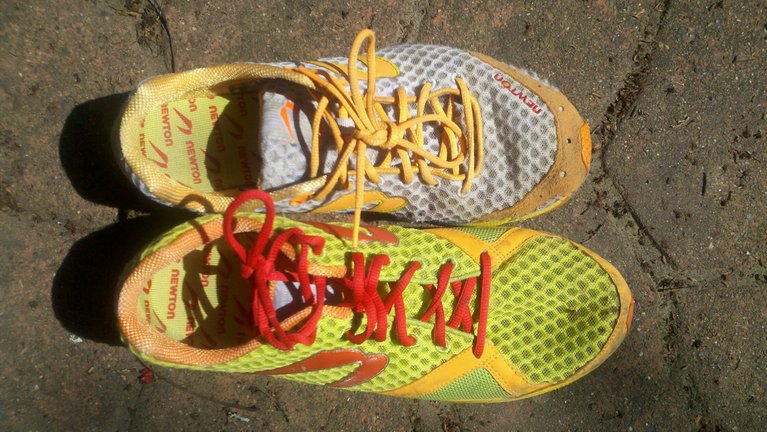
 The Newton MV2 is what I like to refer to as a "goldilocks shoe." The Newton MV2 strikes a nice balance between traditional running shoes and barefoot/minimalist shoes. The Newton MV2 is a lightweight, zero drop shoe, which encourages a natural midfoot/forefoot stride, but a reasonable midsole, as well as lugs placed under the forefoot, allow for more ground protection and a more comfortable ride for those long runs. By including the most important features of barefoot shoes with added forefoot protection has created an in between shoe that you may find to be just right.
The Newton MV2 is what I like to refer to as a "goldilocks shoe." The Newton MV2 strikes a nice balance between traditional running shoes and barefoot/minimalist shoes. The Newton MV2 is a lightweight, zero drop shoe, which encourages a natural midfoot/forefoot stride, but a reasonable midsole, as well as lugs placed under the forefoot, allow for more ground protection and a more comfortable ride for those long runs. By including the most important features of barefoot shoes with added forefoot protection has created an in between shoe that you may find to be just right.

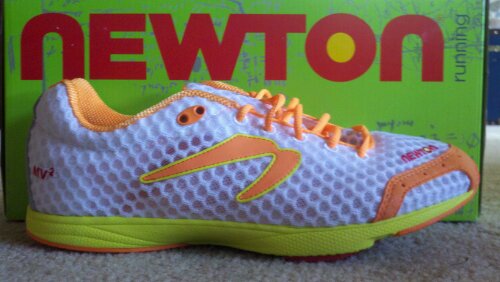
 The distinguishing feature of the Newton MV2 outsole are the lugs beneath the forefoot. Unlike previous Newton models, the Newton MV2 features five lugs rather than four. I believe the idea was to put a lug beneath each metatarsal. beneath each lug is a hollow chamber which allows each lug to compress and then spring back, theoretically allowing for energy return from the shoe. This is what Newton refers to as its patented action/reaction technology.
The distinguishing feature of the Newton MV2 outsole are the lugs beneath the forefoot. Unlike previous Newton models, the Newton MV2 features five lugs rather than four. I believe the idea was to put a lug beneath each metatarsal. beneath each lug is a hollow chamber which allows each lug to compress and then spring back, theoretically allowing for energy return from the shoe. This is what Newton refers to as its patented action/reaction technology.